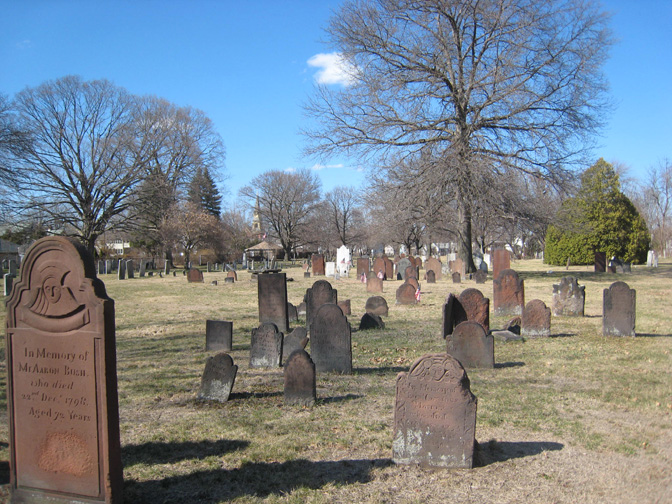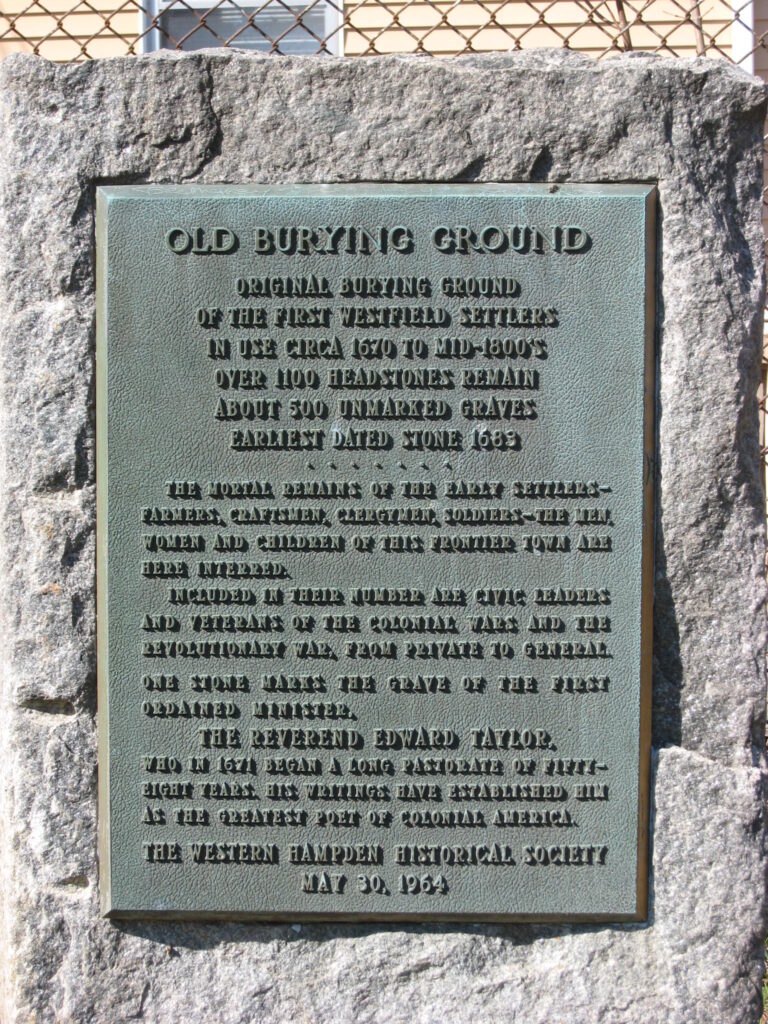This is the third in a series of posts about four generations of my ancestors in colonial Massachusetts and Connecticut. It includes the Bagg, Burt, Phelps, Moseley, Stanley and other related families between 1635 and 1795.
For many of the colonists who fled England to become pioneers in New England in the 1630s, rebuilding their lives once was enough. But not for George Phelps. He helped to found the town of Windsor, Connecticut and raised his family there. Thirty years later, he started over as a founding settler of Westfield, a new town on the edge of the Massachusetts wilderness.
His date and place of birth in England are unknown, but he was probably born around 16131 and he probably came to New England on the ship Recovery in 1634.2 Most of its passengers were from southwest England, and George may have been from the same area.
He initially settled in Dorchester, Massachusetts. Some people in Dorchester complained that the leaders of the Massachusetts Bay Colony were too elitist and autocratic.3 They wanted to be part of a more democratic society. In 1635, a group of unhappy colonists left Dorchester with their minister, Reverend John Warham, determined to found a new community they called Windsor, Connecticut. George was one of them.
A trading post had been built at the spot where the Farmington River flows into the Connecticut River several years earlier, and the indigenous people in the area were friendly to the newcomers and willing to sell them land. The spot was well located for trade and its riverside meadows were fertile, so Warham’s group decided to settle there.

Sixty men, women and children travelled overland with their farm animals, while their possessions were shipped by water. The first winter was so difficult that many of the cattle died and some of the would-be settlers fled back to Dorchester, returning to Windsor in the spring, accompanied by additional settlers.
In 1637, the Pequot Indians began attacking the New England colonists, so the settlers surrounded their houses with a protective wooden palisade. By 1639, the danger had subsided and the people of Windsor constructed the most important building in the community: the church and meeting house. George married Philura Randall, the daughter of Philip Randall, although there is no surviving record of their marriage. They lived in an area known as the Island, overlooking the Farmington River, but not only was that area prone to flooding, in 1640, the house burned.4
Like most of his neighbours, George supported his family as a farmer. According to a 1640 inventory of Windsor properties, he owned nine different tracts of land, including several acres in what was known as the Plimouth Meadow, several properties on the other side of what people called the great river, and several narrow tracts of land that stretched three miles back from the water.5
As well as wheat and Indian corn, George may have grown tobacco, a crop that has been grown in the area since 1640, and he planted 500 apple trees. Apples had been imported to the colony from England and were a staple of the New England diet.

He signed land deeds and his will with a mark, so George probably did not know how to write, however, he did own books.6 He served as a constable in Windsor in 1645 and was on juries a number of times between 1649 and 1667.
George and Philura had five children, including Isaac (my direct ancestor), born 1638, Abraham, born 1642, and Joseph, born 1647.The years 1647 and 1648 were particularly difficult, with many deaths in the community. Two of the Phelps children died in 1647, and Philura died on April 29, 1648.7 George remarried six months later. His second wife was Frances Dewey, the widow of Thomas Dewey, who had had also died in April. Frances had a daughter from her first marriage and five young children from her marriage with Thomas. She and George went on to have three children together: Jacob, born 1649, John, born 1651, and Nathaniel, born 1654.8
In the late 1660s, the Phelps family left Windsor and helped to found Westfield, Massachusetts. Some of their Windsor neighbours made the same move, joining several families who had come from Springfield, Massachusetts to establish the new town. Life was not easy in Westfield, wnich was the westernmost town in Massachusetts, nevertheless, these self-reliant pioneers survived the many hardships they faced and the town grew.
When George Phelps died on May 8, 1687,9 he left his bedding, household goods, some money and the use of part of the house in Westfield to his wife. Frances died in Westfield three years later.
His son Jacob received a four-acre section of the home lot in Westfield that included the house, barn and orchard. To son Isaac, he left “the best coat of my wearing apparel and my mare.”10 He distributed money and his remaining land in Windsor and Westfield between all his sons.
Photo sources:
map: The History and Genealogies of Ancient Windsor, vol. 1, p. 149
Corn mill: photo by Katherine Parker Drake; Windsor Historical Society collection.
Notes:
All the sources for this article are secondary. The article on George Phelps in The Great Migration series by Robert Charles Anderson, published by the New England Historic Genealogical Society (NEHGS), includes references to numerous other sources.
The chapter on George Phelps in The Phelps Family of America was recommended to me by a senior researcher at the NEHGS. Another NEHGS researcher, Alicia Crane Williams, discussed this book on the blog Vita Brevis (https://vita-brevis.org/2018/03/pulling-it-all-together/#more-10613), noting that it was written by a gentleman genealogist in the 19thcentury. Books of this type often contain errors and, in this case, the information about George’s origins in England is wrong.
I used both the book and the online version of The Great Migration Begins. Links to the other digital books about Windsor can be found on ConnecticutHistory.org, https://connecticuthistory.org/towns-page/windsor/.
The organization Descendants of the Founders of Ancient Windsor has published a list of the early settlers of Windsor on its website, http://www.ancientwindsor.org/index.html. See http://www.ancientwindsor.org/founders-list.html.
Sources:
- The Great Migration Begins: Immigrants to New England 1620-1633, Volumes I-III. (Online database: AmericanAncestors.org, New England Historic Genealogical Society, 2010), (Originally published as: New England Historic Genealogical Society. Robert Charles Anderson, The Great Migration Begins: Immigrants to New England 1620-1633, Volumes I-III, 3 vols. 1995), p 445. https://www.americanancestors.org/DB393/i/12107/539/1415511879, accessed March 25, 2018.
- “The Origin of George Phelps” Phelps Family History in America, http://www.phelpsfamilyhistory.com/research/george/index.asp, accessed March 24, 2018.
- Howard, Daniel. A New History of Old Windsor, Connecticut. Windsor Locks, CT: Journal Press, 1935. http://www.archive.org/stream/newhistoryofoldw00howa#page/n5/mode/2up, accessed March 29, 2018.
- Stiles, Henry. The History and Genealogies of Ancient Windsor, Connecticut Including East Windsor, South Windsor, Bloomfield, Windsor Locks, and Ellington. 1635-1891, Vol. 1. Hartford, CT: Case, Lockwood & Brainard Company, 1891, p. 163. https://archive.org/stream/historygenealogi11stil#page/n357/mode/2up, accessed March 24, 2018.
- Anderson, The Great Migration Begins, p 446.
- Oliver Seymour Phelps and Andrew T. Servin, compilers. The Phelps Family of America and their English Ancestors, and other interesting papers, coats of arms and valuable records. Volume II. Pittsfield, MA, Eagle Publishing Company, 1899. “George Phelps the Emigrant, 1630,” p. 1267.
- Connecticut: Vital Records (The Barbour Collection), 1630-1870 (Online Database: AmericanAncestors.org, New England Historic Genealogical Society, 2011.) From original typescripts, Lucius Barnes Barbour Collection, 1928, https://www.americanancestors.org/DB414/i/12316/224/138422806, accessed April 7, 2018
- Anderson, The Great Migration Begins, p 449.
- Massachusetts Vital Records. 1621-1850 (online database: AmericanAncestors.org. New England Historic Genealogical Society, 2001-2016.) https://www.americanancestors.org/DB190/r/253013871, accessed March 21, 2018.
- Anderson, The Great Migration Begins, p 447.





